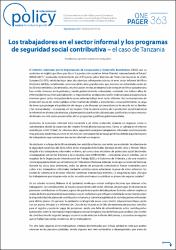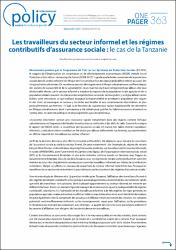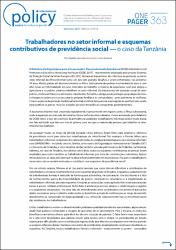Please use this identifier to cite or link to this item:
https://repositorio.ipea.gov.br/handle/11058/15933Full metadata record
| DC Field | Value | Language |
|---|---|---|
| dc.contributor.author | Myamba, Flora | |
| dc.date.accessioned | 2024-10-04T00:13:59Z | - |
| dc.date.available | 2024-10-04T00:13:59Z | - |
| dc.date.issued | 2017 | |
| dc.identifier.uri | https://repositorio.ipea.gov.br/handle/11058/15933 | - |
| dc.description.abstract | "The report by the Organisation for Economic co-Operation and Development (OECD) entitled 'Social Protection in East Africa: Harnessing the Future' (OECD 2017), recently produced by the European Union Social Protection Systems (EU-SPS) project, points to the low coverage rates of social protection in the informal sector in East Africa as one of seven great challenges that will need to be addressed in the next 50 years. For years now, many developing countries in sub-Saharan Africa have been poor and vulnerable, with high rates of informality in their labour markets: the majority of both rural populations involved in agriculture and the urban poor work in the informal sector. Public-sector social protection mechanisms have remained weak or even non-existent; therefore, the burden to protect the population from risks and social and economic shocks has been placed on the families and communities themselves—and mainly on women. This is the essence of traditional (and informal) social protection in sub-Saharan Africa, the perception of which has been used to justify the low resources allocated to this sector in government-led policies and programmes". (...) | en |
| dc.description.abstract | "O Relatório da Organização para a Cooperação e Desenvolvimento Econômico (OCDE) intitulado Social Protection in East Africa: Harnessing the Future (OCDE, 2017), recentemente produzido pelo projeto Sistemas de Proteção Social da União Europeia (EU-SPS), destaca as baixas taxas de cobertura da proteção social no setor informal da África Oriental como um dos sete grandes desafios a serem enfrentados nos próximos 50 anos. Muitos países em desenvolvimento na África Subsaariana são pobres e vulneráveis há anos e com altas taxas de informalidade em seus mercados de trabalho: a maioria da população rural que pratica a agricultura e os pobres urbanos trabalham no setor informal. Os mecanismos de proteção social do setor público continuam fracos ou até mesmo inexistentes. Portanto, a obrigação de proteger a população de riscos e choques econômicos e sociais cabe às próprias famílias e às comunidades – principalmente às mulheres. Essa é a essência da proteção tradicional (e formal) na África Subsaariana: a percepção da qual tem sido usada para justificar os parcos recursos alocados ao setor em políticas e programas governamentais". (...) | pt-br |
| dc.language.iso | en | |
| dc.title | Workers in the informal sector and contributory social insurance schemes—the case of Tanzania | en |
| dc.title.alternative | Los trabajadores en el sector informal y los programas de seguridad social contributiva – el caso de Tanzania | es |
| dc.title.alternative | Les travailleurs du secteur informel et les régimes contributifs d’assurance sociale: le cas de la Tanzanie | fr |
| dc.title.alternative | Trabalhadores no setor informal e esquemas contributivos de previdência social — o caso da Tanzânia | pt-br |
| dc.type | One Pager | |
| dc.rights.holder | International Policy Centre for Inclusive Growth | |
| dc.rights.holder | United Nations Development Programme | |
| dc.location.country | Brasil | |
| dc.description.physical | 1 p. | |
| dc.rights.type | Licença total exclusiva | |
| dc.rights.license | O texto e dados desta publicação podem ser reproduzidos desde que as fontes sejam citadas. Reproduções com fins comerciais são proibidas. | |
| dc.subject.keyword | Workers | |
| dc.subject.keyword | informal sector | |
| dc.subject.keyword | contributory | |
| dc.subject.keyword | social insurance | |
| dc.subject.keyword | schemes | |
| dc.subject.keyword | case | |
| dc.subject.keyword | Tanzania | |
| ipea.access.type | Acesso Aberto | |
| ipea.researchfields | N/A | |
| ipea.classification | Desenvolvimento Social | |
| ipea.classification | Previdência. Previdência Social | |
| Appears in Collections: | Publicações do IPC-IG | |
Files in This Item:
| File | Description | Size | Format | |
|---|---|---|---|---|
| en_OP363_Workers_in_the_informal_sector_and_contributory.pdf | 49.9 kB | Adobe PDF |  View/Open | |
| es_OP363SP_Los_trabajadores_en_el_sector_informal.pdf | 54.4 kB | Adobe PDF |  View/Open | |
| fr_OP363FR_Les_travailleurs_du_secteur_informel.pdf | 50.84 kB | Adobe PDF |  View/Open | |
| pt-br_OP363PT_Trabalhadores_no_setor_informal_e_esquemas.pdf | 54.79 kB | Adobe PDF |  View/Open |
Items in DSpace are protected by copyright, with all rights reserved, unless otherwise indicated.

